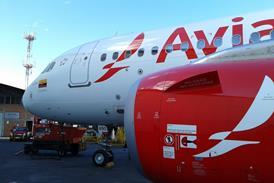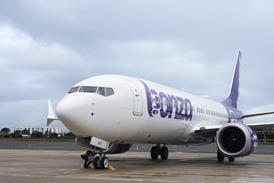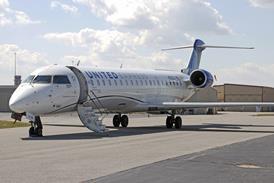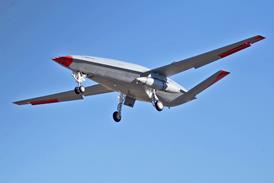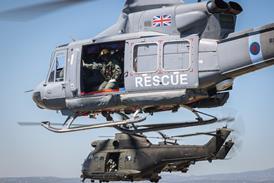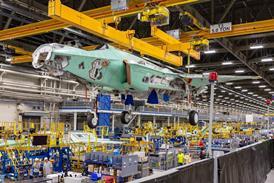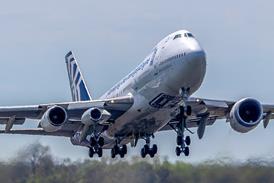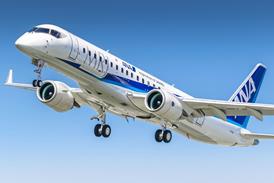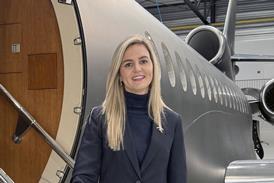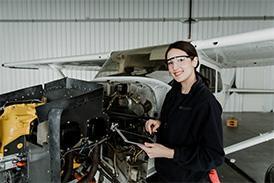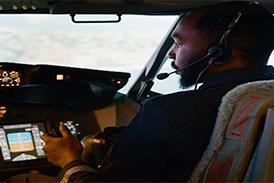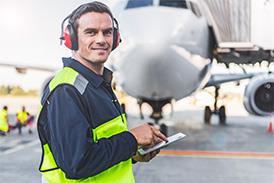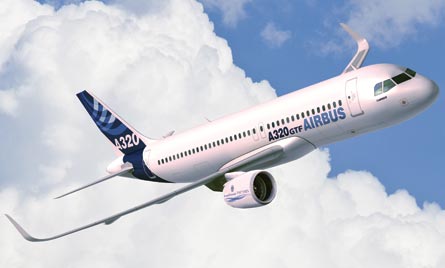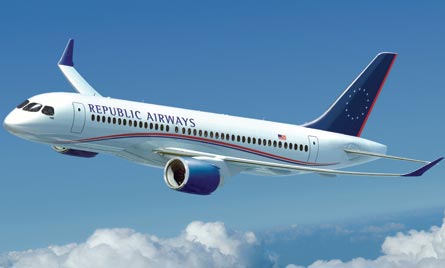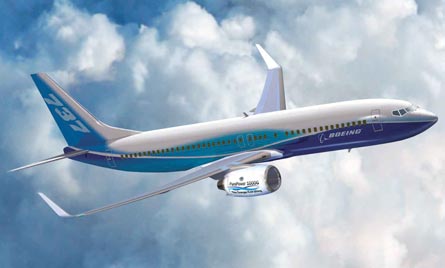At the 2008 Farnborough air show Airbus's chief salesman John Leahy dropped the first serious hint that the airframer could counter the Bombardier CSeries with a Pratt & Whitney geared turbofan airliner of its own, in the form of a re-engined A320. Two years on, and the likelihood of such a development is odds-on, and we could well see Leahy with pen in hand signing his first customers at the 2010 show - if not before.
But in the 20 months or so since the last Farnborough - when Bombardier announced the launch of the CSeries underwritten by a deal with Lufthansa for up to 60 aircraft - the choice of advanced turbofans has broadened to also include an offering from CFM International, while Boeing has entered the fray with a re-engining study of its own.
Bombardier's promise that its P&W PW1000G GTF-powered, 110- to 145-seat CSeries twinjet would deliver a double-digit fuel burn advantage over the current designs certainly seems to have set the cat among the pigeons. Even Leahy acknowledges that the "surprising amount of interest" Airbus has seen for its proposed re-engined A320 family, just might have been generated by Bombardier's CSeries advantage claims. But he points out that if Airbus goes ahead with the re-engined A320, "you could have your 15% lower fuel burn, and still have your A320".
|
|---|
The fact that the Bombardier twinjet is now beginning to rack up sales - it recently landed a key order from US regional Republic Airways for up to 80 aircraft - has piled on the pressure. There is also the growing prospect of a second threat emerging in the form of a new or derivative small mainline airliner from Embraer powered by advanced turbofans.
P&W and CFM have not been slow to get their new engines on to clean-sheet 150-seat designs in development, with the latter's Leap X advanced turbofan selected to power China's Comac C919 and the GTF being adopted for Russia's MS-21 twinjet.
Meanwhile, some existing Airbus/Boeing single-aisle customers - for example lessor AerCap - have fanned the flames by warning that they will not place new orders until there is clarity in the "big two's" re-engining plans.
"With the Republic order, it's clear that the CSeries is a threat to Airbus and Boeing," says Richard Aboulafia, who is vice-president analysis at US consultancy Teal Group. "While the 100/130-seat part of the single-aisle market is small and getting smaller over time, neither big prime wants to lose 20-30% of their narrowbody sales and production volume. Airbus and Boeing are no longer in the driver's seat here. They need to move ahead with re-engined A320 and 737 families, with a launch this year."
|
|---|
While the two CSeries models currently planned only threaten the lower end of Airbus and Boeing's single-aisle product lines (ie A318/A319 and 737-600/700), several observers view the eventual development of a third variant with 150 seats as a no-brainer. JP Morgan analyst Joseph Nadol believes such a derivative is already in the works and that is a key reason why Airbus and Boeing are taking a hard look at re-engining.
Boeing is about to give 737 customers a 2% fuel burn improvement with a mid-life update comprising aerodynamic, engine and cabin upgrades. Airbus has responded with its "sharklet" winglet upgrade, due to come on stream in 2012 and deliver a 3.5% gain.
Boeing Commercial Airplanes president Jim Albaugh says that deciding on the next stage, a re-engining of the 737, is a "very complex algorithm" that must take into account the dispatch reliability of an existing airframe with a new engine, as well as any maintenance implication of introducing a new model alongside existing variants by operators such as Southwest Airlines.
"It's not as easy to just say, you can get 10-15% efficiency, let's go do it," he says.
"One thing I've learned is that there's nothing simple about a derivative airplane. There's certainly nothing simple about a re-engine. If you did a re-engine the pylon would change, the empennage would change, you'd have to raise the front gear a little, but drive some different loads into the airplane, drive some different loads into the wing."
The CSeries, which is due to enter service in late 2013, has the big advantage of being an all-new airliner featuring a carbonfibre wing and an aluminium lithium airframe. But this means it is not without its technical risks, and there are also concerns that the way Bombardier has widely dispersed production partners may also prove to be a headache.
"There are enormous risks to the CSeries production plan," says Aboulafia. "The major aerostructures partner, Chinese partner Shenyang, has never done anything like this before, and Bombardier would not be able to copy Boeing on the 787 and bring this work in house if Shenyang proved unable to execute on the fuselage. Even without that factor, this project is likely to strain Bombardier's resources to breaking point."
The clue to GTF's secret to enhanced efficiency is in its name - a 3:1 reduction gearbox that is located aft of the fan, says Bob Keady, senior vice-president sales at P&W. "This permits the low-pressure turbine [LPT] and the fan to each operate at their optimum speeds, thus maximising propulsive efficiency."
Although P&W has undertaken rigorous testing of the fan-drive gearbox, the engine maker has only just begun testing the engine's core - and this is an area where it came unstuck with its last civil turbofan, the PW6000, that had to undergo a redesign from which it never recovered.
Aboulafia thinks that P&W's new engine is "ready", but the one key question is whether the proposed second-generation GTF, which the engine maker has talked about developing later in the current decade - and that could be the one that powers any upgraded A320 or 737 - is more advanced than that powering the CSeries.
"That would put the Bombardier aircraft at even more of a disadvantage relative to the established players in this market," he says.
The CFM Leap X uses other advances to match the GTF's 10-15% lower fuel burn over today's engines. Its heritage can be traced to technology developed over the past 10-15 years by partners GE and Snecma and engines such as the GE90 and GEnx, says executive vice-president Chaker Chahrour.
|
|---|
HIGHER BYPASS RATIO
The lower fuel burn comes roughly 50/50 from a significantly higher bypass ratio and the advanced efficiency of the engine's new core, he adds: "The engine has double the bypass ratio [of current engines] and features composite fan blades - the first time in an engine of this size. The core has a two-stage high-pressure turbine, compared with single stage today, featuring advanced materials."
One complication that CFM has avoided is the partner squabbles its rival is enduring. While P&W confirms that it has offered its engine to Airbus and Boeing, its "preferred route to market" - and the one favoured by Airbus - is through its International Aero Engines partnership. This consortium, in which P&W is the joint lead partner with Rolls-Royce, has just one product, the V2500 engine, which powers the A320.
IAE has confirmed that it is evaluating a new powerplant as one option to compete against the Leap X, with chief executive Ian Aitken saying that it can adopt technology developed by P&W and the other IAE partners "to put together an optimum engine".
However, P&W is losing patience, and its president David Hess recently warned the company "isn't afraid of going it alone" with its bids to Airbus and Boeing.
Aboulafia says the IAE alliance remains a major complication: "R-R doesn't want to work on a GTF, and Airbus, so far, wants to stick with IAE. One wonders whether Rolls has a back-up plan. We are looking at a very good chance that both airframers adopt new narrowbody engines around 2015, so unless R-R has something up its sleeve it's either GTF or abandoning this market."
R-R is working on a new small engine, but civil aerospace president Mark King is non-committal about near-term prospects: "Will it be on a re-engined aircraft? Maybe," he says.
Airbus and Boeing concur that there will not be any "clean-sheet" designs from them until at least 2020 (Airbus's latest estimate is for 2024-25). The rivals have each committed to deciding what they will do about putting new engines on upgraded versions of their current aircraft by year-end. Leahy wants the decision "sorted out" by July's Farnborough air show, with service entry targeted for the end of 2015, and Airbus is already courting potential launch customers.
The prospect of a re-engined A320 or 737 is expected, says Bombardier Commercial Aircraft president Gary Scott. "We'd always imagined that Airbus and Boeing might re-engine, but we believe we have a nice window of opportunity with the only all-new airplane."
Scott says that the CSeries's claimed 20% fuel burn advantage comes "roughly half each" from the engine and airframe. "So if they put the same engine on their airframe then they'll probably cut that advantage in half, but they won't have the new airplane that we have and it won't be optimally designed."
Seasoned industry veteran Steven Udvar-Hazy - formerly boss of International Lease Finance - is not convinced the numbers work for the re-engined single-aisles. He says that a potential 12-15% fuel efficiency improvement gained from re-engined airframes could be wiped out by yet-to-be determined maintenance and capital costs.
"These are questions no-one is coming up with answers to," he says.
But Aboulafia believes the reality of sustained high fuel costs outweighs concerns about any technical risks these new engines might offer. "That has clearly dampened any fears about introducing a next-generation engine," he says. "The emphasis is on fuel efficiency, not technological risk or the costs of introducing new equipment."
Another inevitable complication for the current A320 and 737 models if interim upgraded variants are developed is that they will "cannibalise the backlogs for their current models", says Scott. "Customers will want to swap to the new version. There is also a [negative] impact on the residual values of the installed fleet."
This view is supported by several analysts, with Rikard de Jounge, a senior director at appraisers Avitas, saying that if the upgraded A320/737 variants go ahead, the owners of current generation aircraft "will be left holding the bag. The economic life of their assets will be curtailed."
Klaus Heinemann, chief executive of lessor AerCap, says that if the pattern of previous eras is repeated, then there is "roughly a five- year lag" from the introduction of the upgraded aircraft to impacting the residuals of current-generation models.
"Take the 737 Classic versus the NG situation: five or six years into the programme of the NG you started to see significant impact on the residuals of the Classic. So if these new aircraft come into the market in 2015, we would expect to see an impact on residuals in 2020."
ROBUST RESIDUALS
Boeing's vice-president of marketing Randy Tinseth is confident the size of the current 737's installed fleet should ensure residuals are robust.
"More than 5,000 have been ordered. It's an airplane whose value is well understood in this market and it is going to take years to replace this fleet," he says.
The narrowbody sector is central to AerCap's lease portfolio. Heinemann says this the current uncertainty over the airframers' next move is one of the reasons why it is holding off from placing more narrowbody orders. "We want to observe a little bit how these discussions pan out with the manufacturers," he says, and expects more clarity on re-engining talks "by the middle of the year".
At the 2008 Farnborough air show Airbus's chief salesman John Leahy dropped the first serious hint that the airframer could counter the Bombardier CSeries with a
Pratt & Whitney geared turbofan airliner of its own, in the form of a re-engined A320. Two years on, and the likelihood of such a development is odds-on, and we could well see Leahy with pen in hand signing his first customers at the 2010 show - if not before.
But in the 20 months or so since the last Farnborough - when Bombardier announced the launch of the CSeries underwritten by a deal with Lufthansa for up to 60 aircraft - the choice of advanced turbofans has broadened to also include an offering from CFM International while Boeing has entered the fray with a re-engining study of its own.
Bombardier's promise that its P&W PW1000G GTF-powered, 110-145 seat CSeries twinjet would deliver a double-digit fuel burn advantage over the current designs certainly seems to have set the cat amongst the pigeons. Even Leahy acknowledges that the "surprising amount of interest" Airbus has seen for its proposed re-engined A320 family, just might have been generated by Bombardier's CSeries advantage claims. But he points out that if Airbus goes ahead with the re-engined A320 "you could have your 15% lower fuel burn, and still have your A320".
The fact that the Bombardier twinjet is now beginning to rack up sales - it recently landed a key order from US regional Republic Airways for up to 80 aircraft - has piled on the pressure. There is also the growing prospect of second threat emerging in the form of a new or derivative small mainline airliner from Embraer powered by advanced turbofans.
Both P&W and CFM International have not been slow to get their new engines on to clean-sheet 150-seat designs in development, with the latter's Leap X advanced turbofan selected to power China's Comac C919 and the GTF being adopted for Russia's MS-21 twinjet.
Meanwhile some existing Airbus/Boeing single-aisle customers - for example lessor AerCap - have fanned the flames by warning that they will hold from placing new orders until there is clarity in the "big two's" re-engining plans.
"With the Republic order, it's clear that the CSeries is a threat to Airbus and Boeing," says Richard Aboulafia, who is vice president analysis at US consultancy Teal Group. "While the 100/130-seat part of the single aisle market is small and getting smaller over time, neither big prime wants to lose 20-30% of their narrowbody sales and production volume. Airbus and Boeing are no longer in the driver's seat here. They need to move ahead with re-engined A320 and 737 families, with a launch this year."
While the two CSeries models currently planned only threaten the lower end of Airbus and Boeing's single-aisle product lines (ie A318/A319 and 737-600/700), several observers view the eventual development of a third variant with 150 seats as a no-brainer. JP Morgan analyst Joseph Nadol believes such a derivative is already in the works and that is a key reason why Airbus and Boeing are taking a hard look at re-engining.
Boeing is about to give 737 customers a 2% fuel burn improvement with a mid-life update comprising aerodynamic, engine and cabin upgrades. Airbus has responded with its "sharklet" winglet upgrade, due to come on stream in 2012 delivering a 3.5% gain.
Boeing Commercial Airplanes president Jim Albaugh says that deciding on the next stage, a re-engining of the 737, is a "very complex algorithm" that must take into account the dispatch reliability of an existing airframe with a new engine, as well as any maintenance implication of introducing of a new model alongside existing variants by operator such as Southwest Airlines.
"It's not as easy to just say, you can get 10-15% efficiency, let's go do it," he says.
"One thing I've learned is that there's nothing simple about a derivative airplane. There's certainly nothing simple about a re-engine. If you did a re-engine the pylon would change, the empennage would change, you'd have to raise the front gear a little but, drive some different loads into the airplane, drive some different loads into the wing."
The CSeries, which is due to enter service in late 2013, has the big advantage of being an all-new airliner featuring a carbonfibre wing and an aluminium lithium airframe. But this means it is not without its technical risks, and there are also concerns that the way Bombardier has widely dispersed production partners may also prove to be a headache.
"There are enormous risks to the CSeries production plan," says Aboulafia. "The major aerostructures partner, Chinese partner Shenyang, has never done anything like this before, and Bombardier would not be able to copy Boeing on the 787 and bring this work in house if Shenyang proved unable to execute on the fuselage. Even without that factor, this project will likely strain Bombardier's resources to the breaking point."
The clue to GTF's secret to enhanced efficiency is in its name - a 3:1 reduction gearbox which is located aft of the fan, says Bob Keady, senior vice president sales at P&W. "This permits the low pressure turbine (LPT) and the fan to each operate at their optimum speeds, thus maximising propulsive efficiency."
Although P&W has undertaken rigorous testing of the fan-drive gearbox, the engine maker has only just begun testing the engine's core - and this is an area where it came unstuck with its last civil turbofan, the PW6000, which had to undergo a redesign from which it never recovered.
Aboulafia thinks that P&W's new engine is "ready", but the one key question is whether the proposed second generation GTF which the engine maker has talked about developing later in the current decade - that could possibly be the one that powers any upgraded A320 or 737 - is more advanced than that powering the CSeries.
"That would put the Bombardier aircraft at even more of a disadvantage relative to the established players in this market," he says.
The CFM Leap X uses other advances to match the GTF's 10-15% lower fuel burn over today's engines. Its heritage can be traced to technology developed over the past 10-15 years by partners GE and Snecma and engines such as the GE90 and GEnx, says executive vice president Chaker Chahrour.
The lower fuel burn comes roughly 50/50 from a significantly higher bypass ratio and the advanced efficiency of the engine's new core, he adds: "The engine has double the bypass ratio [of current engines] and features composite fan blades - the first time in an engine of this size. The core has a two-stage high pressure turbine, compared with single stage today, featuring advanced materials."
One complication that CFM has avoided is the partner squabbles its rival is currently enduring. While P&W confirms that it has offered its engine to both Airbus and Boeing, its "preferred route to market" - and the one favoured by Airbus - is through its International Aero Engines partnership. This consortium, in which P&W is the joint lead partner with Rolls-Royce, has just one product, the V2500 engine which powers the A320.
IAE has confirmed that it is evaluating a new powerplant as one option to compete against the Leap X, with chief executive Ian Aitken saying that it can adopt technology developed by P&W and the other IAE partners "to put together an optimum engine."
However P&W is losing patience, and the president David Hess recently warned the company "isn't afraid of going it alone" with its bids to Airbus and Boeing.
Aboulafia says the IAE alliance remains a major complication: "R-R doesn't want to work on a GTF, and Airbus, so far, wants to stick with IAE. One wonders whether Rolls has a backup plan. We are looking at a very good chance that both airframers adopt new narrowbody engines around 2015, so unless R-R has something up its sleeve it's either GTF or abandoning this market."
Although R-R is working on a new small engine, civil aerospace president Mark King is non-committal about near-term prospects: "Will it be on a re-engined aircraft? Maybe," he says.
Both Airbus and Boeing concur that there won't be any "clean-sheet" designs from them until at least 2020 (Airbus's latest estimate is for 2024-25). The two rivals have both committed to deciding what they will do about putting new engines on upgraded versions of their current aircraft by year-end. Leahy wants the decision "wrapped up" by July's Farnborough air show, with service entry targeted for the end of 2015, and Airbus is already courting potential launch customers.
The prospect of a re-engined A320 or 737 is not entirely unexpected, says Bombardier Commercial Aircraft president Gary Scott. "We'd always imagined that Airbus and Boeing might re-engine, but we believe that we have a nice window of opportunity with the only all-new airplane."
Scott says that the CSeries's claimed 20% fuel burn advantage comes "roughly half each" from the engine and airframe. "So if they put the same engine on their airframe then they'll probably cut that advantage in half, but they won't have the new airplane that we have and it won't be optimally designed."
Seasoned industry veteran Steve Udvar-Hazy - formerly boss of International Lease Finance - isn't convinced the numbers work for the re-engined single-aisles. He says that a potential 12% to 15% fuel efficiency improvement gained from re-engined airframes could be wiped out by yet-to-be determined maintenance and capital costs.
"These are questions no one is coming up with answers to," he says.
But Aboulafia believes the reality of sustained high fuel costs outweighs concerns about any technical risks these new engines might offer. "That has clearly dampened any fears about introducing a next generation engine," he says. "The emphasis is on fuel efficiency, not technological risk or the costs of introducing new equipment."
Another inevitable complication for the current A320 and 737 models if interim upgraded variants are developed, is that they will "canabalise the backlogs for their current models", says Scott. "Customers will want to swap to the new version. There is also a [negative] impact on the residual values of the installed fleet."
This view is supported by several analysts, with Rikard de Jounge, a senior director at appraisers Avitas, saying that if the upgraded A320/737 variants go ahead, the owners of current generation aircraft "will be left holding the bag. The economic life of their assets will be curtailed."
Klaus Heinemann, chief executive of lessor AerCap, says that if the pattern of previous eras is repeated, then there is "roughly a five year lag" from the introduction of the upgraded aircraft to impacting the residuals of current generation models.
"If you take the 737 Classic versus the NG situation, five or six years into the programme of the NG you started to see significant impact on the residuals of the Classic. So if these new aircraft come into the market in 2015, we would expect to see an impact on residuals in 2020."
Boeing's vice president of marketing Randy Tinseth is confident the size of the current 737's installed fleet should ensure residuals are robust: "More than 5,000 have been ordered. It's an airplane whose value is well understood in this market and it is going to take years to replace this fleet," he says.
The narrowbody sector is central to AerCap's lease portfolio, and Heinemann says this the current uncertainty over the airframers' next move is one of the reasons why it is holding off from placing more narrowbody orders: "We want to observe a little bit how these discussions pan out with the manufacturers," he says, and expects more clarity on re-engining talks "by the middle of the year".
LINKS
Source: Flight International

